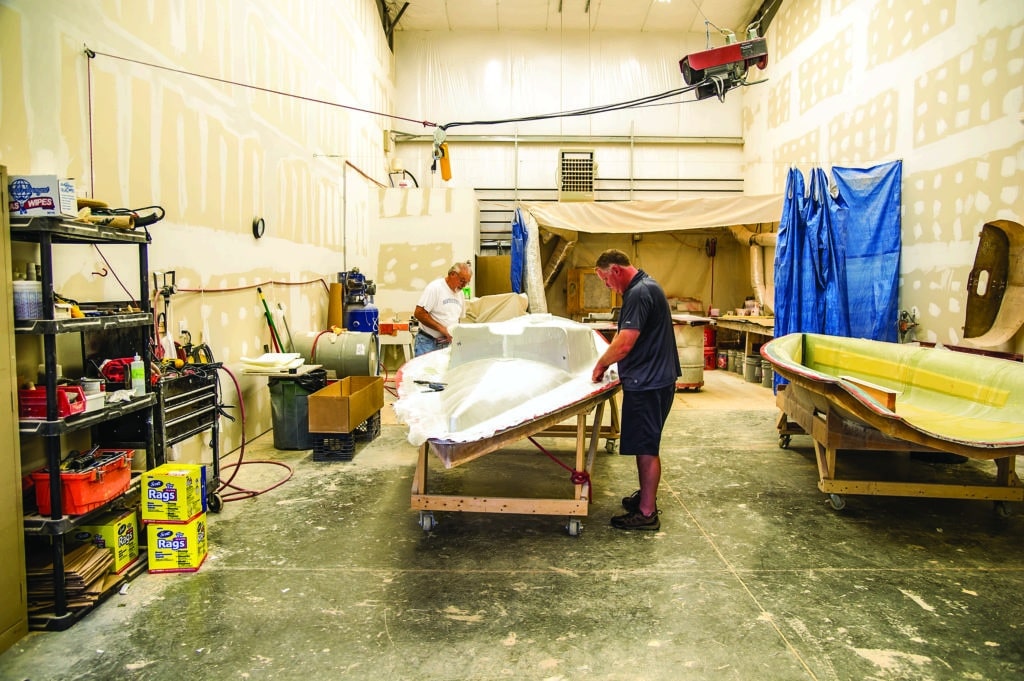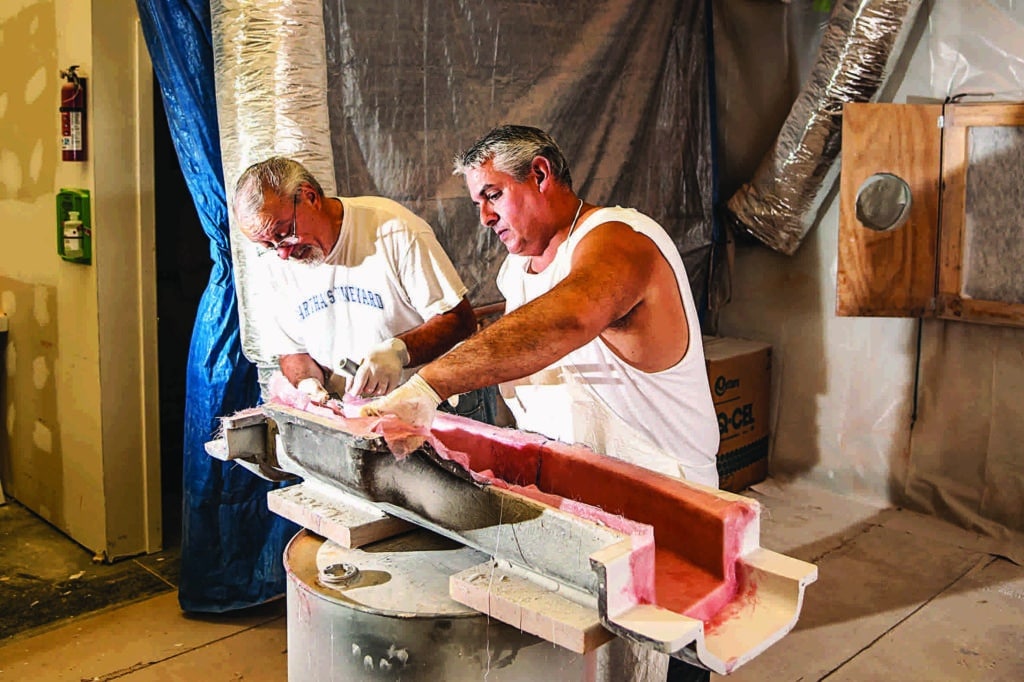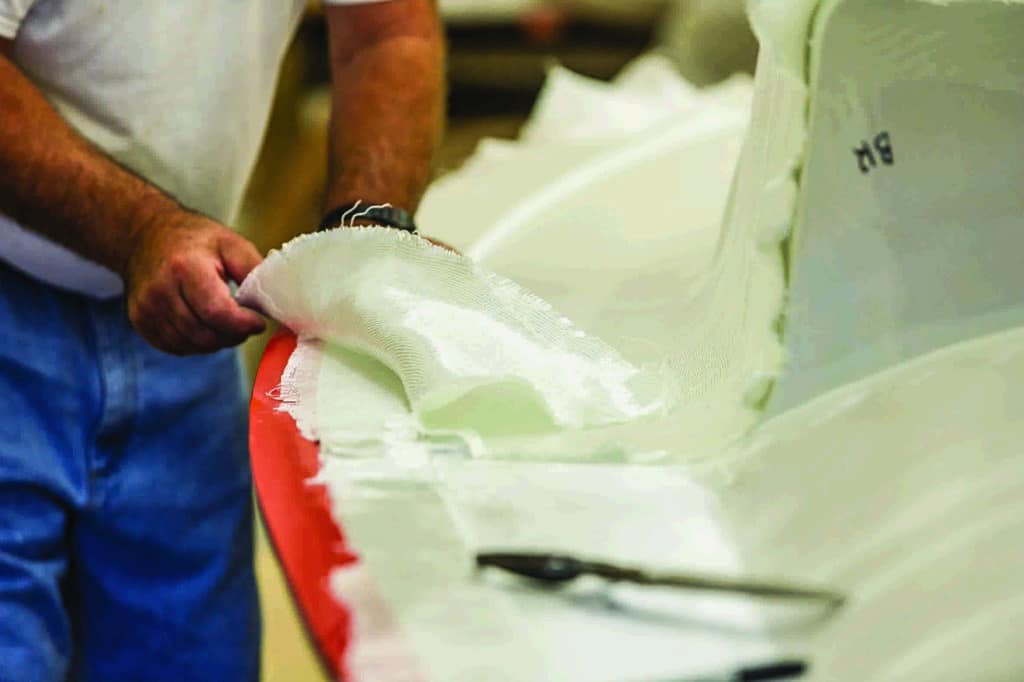
The backroom of Zim Sailing’s headquarters in Warren, Rhode Island, Club 420s, Optimists, Flying Juniors, Bytes, 29ers and Zim 15s are stacked to the ceiling. Literally. The retail store out front is similarly crammed with sailing gear. I hear Bob Adam long before I see him. His voice rises above ringing phones and screeching screw guns fastening hardware to glistening new hulls. Adam is the fast-talking, fast-moving salesman whose enthusiasm precedes him, and on this day he’s jazzed about the orderly chaos surrounding us. The company is bursting out of the 11,500-square-foot commercial space it now occupies, and house-hunting is underway for something twice the size. From its humble beginnings as a builder of Optimists and Club 420s, Zim is now America’s fastest-growing hustler of sailing dinghies. But still there’s this popular notion that it’s just getting started. Zim, you ask?
It’s a fair question, given that founder Steve Perry first hung his shingle in 2008, not far from rival LaserPerformance (formerly Vanguard Sailboats), the Goliath of small-boat production in the States. Back in the day, Perry was in charge of production and streamlining costs at Vanguard, until his position was streamlined in 2007.
After Perry got his pink slip, he entertained buying McLaughlin Boat Works, the company that builds Optimist dinghies. That didn’t work out. So with the approval of his wife, Perry bet the house and struck out on his own with “next to nothing.” The timing, he says, could not have been worse, and his new business had a head-on collision with the recession.
“We’ve been going against the grain for the last seven years,” he says with a smile.
In its first year, Zim started building Optimist dinghies with a group in China. In early 2009, Perry shipped his 420 tooling to China so the company could expand its product line. When he didn’t know where the next order was going to come from, the parts business kept things afloat. To spread the word and make the business viable, Perry and Adam have been on the road as much as Willie Nelson. They’ve been everywhere, driving more than 25,000 miles per year to more than 25 regattas with the big trailer in tow. The 12-by-7-foot trailer is a portable showroom, the mothership for all youth sailors who forgot or broke something they need that day.

“Showing up at regattas is critical,” says Adam. “When Mom comes running over to you after Johnny launched his Optimist, and she has the tiller in one hand and the extension in the other, that’s when you can really make a difference. Not everyone needs a spray top to go sailing, but they need that tiller extension attached to the tiller.”
In fact, Zim’s presence is so ubiquitous at youth regattas these days that many sailors assume Zim Sailing is all about parts. The partners are quick to point out the reality, however, which is that Zim carries 14 boats in its line, with individual offerings for training, recreational and performance sailing. By proving they could effectively move spare parts, the Zim partners earned enough trust to sell fleets to clubs and community sailing programs. The orders started coming in, first with a fleet for Duxbury Bay Maritime School in Massachusetts, then Sail Newport in Rhode Island. Then they finally cracked into the college scene, with fleets going to Fordham, Columbia and the University of New Hampshire. To this day, customers have the owners’ cellphone numbers. And, yes, they frequently deliver on weekends.
Having risen from obscurity to stakeholder, Zim has established itself firmly in the competitive small-dinghy market. LaserPerformance, once the supreme leader in small-boat production, declined to provide sales figures, but one industry expert says LaserPerformance North America currently sells nearly 300 boats a year to the collegiate market. Add in Lasers and Sunfish, as well as recreational boats like the Pico and Bug, and it’s estimated to be a bit shy of 1,000 boats per year.
Yet where LaserPerformance once ruled the waves, Zim and other builders like the family-owned Melges Performance Sailboats, in Zenda, Wisconsin, have accelerated efforts to claim a larger piece of the audience. For these challengers in small-boat sales, the market is small — only in the hundreds of boats per year.
Melges’ president, Andy Burdick, says it builds around 200 scows per year. The latest addition to its line is the Melges 14, designed by Reichel/Pugh. Meanwhile Whitecap Composites is a boutique builder in Peabody, Massachusetts, and builds around 100 boats per year. Partner Paul Zimmerman notes that they build boats to customer specs. When Tufts wanted a new fleet of Larks, for example, they collaborated on a new deck layout for the boat. Whitecap also built a fleet of the next-generation Tech dinghy for MIT. The carbon-fiber boats are 150 pounds lighter than the previous-generation Tech, and actually plane.
Independent specialty boat-builders, like Jibetech in Portsmouth, Rhode Island, round out the market. President Andy Pimental builds Snipes, Y Flyers, Sea Dogs and Finns with an output of approximately 15 boats per year.
Amid this competitive set in 2014, Zim built 75 FJs, Zim 15s, Bytes and Mega Bytes at its Bristol, Rhode Island, facilities, and imported 270 Optis and Club 420s for a total of 345 boats.
The word “Zim” is an abbreviation for Zou Inter Marine, a boatbuilder in Qingdao, Shandong, China, which is a partner. Perry and production manager Zimmermann (no relation to the company name) visit the factory a few times a year and have created numerous quality-control protocols for their boats.

Their focus on the dinghy market keeps Zim on task. “I don’t think we’d want to be everything to all people,” says Perry. “We want to be great, the best at the boats we have. We don’t want to be an apparel company. We don’t want to go into big boats. Dinghies are what we do.”
When LaserPerformance stopped providing boats to the US Sailing Championships in 2012, Zim stepped into the void with Zim 420s and Byte CIIs. Then, in 2014, Zim debuted the Zim 15 at US Sailing team racing events. Designed by Steve Clark and built in Rhode Island by a team led by Zim’s veteran boatbuilders Greg Ormond and Gill Oliveira, the Zim 15 is all about speed. Even its development was quick. In only six months, the Zim 15 went from CAD drawings to 24 boats competing at the 2014 US Team Racing Championship for the George R. Hinman Trophy.
“They’re a really good partner for us,” says Jack Gierhart, the executive director of US Sailing. “They’re benefiting from our programs, and our programs are benefiting from their support. They’re constantly looking at boats that can support the growth of sailing or a sustainable future for it.” While most of the boats piled high in Zim’s Warren facilities are bound for racing or club programs, they’ve also expanded into the broader market of entry-level recreational sailing. Take the Dragon Pram from Holland, a rotomolded Optimist dinghy. It’s only 4 pounds heavier than a competition-grade Opti, but retails at $2,200 with sail and rig. Zim has also added stand-up paddleboards to the mix, and sold 80 of them to camps. “Our biggest market potential is the camp market and recreational — beach houses, lake houses,” says Adam.
Dealers have responded positively to Zim’s business model, which is to deliver a product at a fair price on time. “Steve is a very detail-oriented guy,” says George Yioulos, of West Coast Sailing. “He never gets too excited about things; he’s a very ‘by-the-books’ kind of guy, a straight shooter. The dinghy market needs someone who is reliable. If I call in an order for 10 FJs, he gets it done. If I need twenty 420s in certain colors, they show up.” Since starting in 2008, Zim has gone from zero boats sold to 490 boats sold by the middle of 2015. Perry says the company’s U.S.-based manufacturing is growing, and at some point the economics of building domestically instead of abroad will swing back to favor the United States. In the past five years, the cost to import a boat from Asia has doubled on a cost-per-boat basis. As long as they keep hustling, Perry reckons, they have all the potential to be the next big thing in small-boat building, and now that they have a dozen full-time employees and have moved into a 24,000-foot facility, they’ve got all the assets they need. For now, at least.









